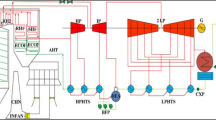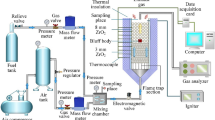Abstract
Growing need for non-renewable energy, like petroleum, and its extraction challenges urge scientists to prioritize renewable resources for sustainable energy. Extensive research is addressing domestic LPG overconsumption and energy-saving. This study focuses on enhancing energy efficiency by adding fins to the bottom of specific cookware. To achieve this goal, a study involves the analysis of up to five stainless steel cookwares, each equipped with a unique fin setup designed to enhance thermal efficiency, raise temperatures more effectively, reduce gas consumption, optimize gas flow rates, and assess various dimensionless numbers. Results shows that among all the five cookwares, Cookware 3 (CW3) outperformed by showing the thermal efficiency of 61.5% to the gas flow rate at 15.27 mL s−1. This modified cookware showed an improved thermal efficiency (4.065% at gas flow rate of 15.27 mL s−1) when compared to the performance of a normal cookware with no fin arrangement present. In addition, the experimental data are validated using ANSYS Fluent software and MATLAB platform with Deep Neural Network-based Binary Bat algorithm (DNN-BBA). The results of the DNN-BBA technique showed a strong correlation with the actual results for temperature increase, thermal efficiency, gas consumption, Nusselt number, Prandtl number, and Rayleigh number. Additionally, the present study is able to maintain the burner's thermal efficiency at a higher level of 3%, compared to the previous study which achieved 2.5%.


















Similar content being viewed by others
Data availability
Data sharing not applicable to this article as no datasets were generated or analysed during the current study.
References
Karunanithy C, Shafer K. Heat transfer characteristics and cooking efficiency of different sauce pans on various cooktops. Appl Thermal Eng. 2016;93:1202–15.
Thacker KS, Barger KM, Mattson CA. Balancing technical and user objectives in the redesign of a Peruvian cookstove. Development Eng. 2017;2:12–9.
Liu C, Teng J, Chu J-C, et al. Experimental investigations on liquid flow and heat transfer in rectangular microchannel with longitudinal vortex generators. Int J Heat Mass Transfer. 2011;54(13–14):3069–80.
Hou S-S, Lee C-Y, Lin T-H. Efficiency and emissions of a new domestic gas burner with a swirling flame. Energy Convers Manag. 2007;48(5):1401–10.
Ko Y-C, Lin T-H. Emissions and efficiency of a domestic gas stove burning natural gases with various compositions. Energy Convers Manag. 2003;44(19):3001–14.
Boggavarapu P, Ray B, Ravikrishna RV. Thermal efficiency of LPG and PNG-fired burners: experimental and numerical studies. Fuel. 2014;116:709–15.
Tiwari AK, Ghosh P, Sarkar J, Dahiya H, Parekh J. Numerical investigation of heat transfer and fluid flow in plate heat exchanger using nanofluids. Int J Thermal Sci. 2014;85:93–103.
Meshram A, Jaiswal AK, Khivsara SD, Ortega JD, Ho C, Bapat R, Dutta P. Modeling and analysis of a printed circuit heat exchanger for supercritical CO2 Power Cycle Applications. Appl Thermal Eng. 2016;109:861–70. https://doi.org/10.1016/j.applthermaleng.2016.05.033.
Deng Y, Menon S, Lavrich Z, Wang H, Hagen CL. Design, simulation, and testing of a novel micro-channel heat exchanger for natural gas cooling in automotive applications. Appl Thermal Eng. 2017;110:327–34.
Islam A, Roy H, Rahman MM. Energy efficiency study of household natural gas burner using pot-bottom shield and modified pot arrangement. Energy Rep. 2022;8:12871–85.
Zheng D, Guo X. Analytical prediction and analysis of electromagnetic-thermal fields in PM eddy current couplings with injected harmonics into magnet shape for Torque Improvement. IEEE Access. 2020;8:60052–61.
Zobeiry N, Humfeld KD. A physics-informed machine learning approach for solving heat transfer equation in advanced manufacturing and engineering applications. Eng Appl Artificial Intell. 2021;101: 104232.
Aoyama M, Thimm W, Knoch M, Ose L. Proposal and challenge of Halbach Array type induction coil for Cooktop Applications. IEEE Open J Ind Appl. 2021;2:168–77.
Das M, Ganguly R, Datta A, Verma MM, Bera AK. Computational fluid dynamic analyses of flow and combustion in a domestic liquefied petroleum gas cookstove burner—part II: burning characteristics and overall performance. ASME J Thermal Sci Eng Appl. 2020;12(3): 031011.
Wichangarm M, Matthujak A, Sriveerakul T, Sucharitpwatskul S, Phongthanapanich S. Investigation on thermal efficiency of LPG cooking burner using computational fluid dynamics. Energy. 2020;203: 117849.
Plumed E, Lope I, Acero J. Modeling and design of cookware for induction heating technology with balanced electromagnetic and thermal characteristics. IEEE Access. 2022;10:83793–801.
Alberto P, Acero J, Carretero C, Sergio L, Burdio JM. Electromagnetic modeling and analysis of multimaterial cookware for domestic induction heating. IEEE Access. 2023;11:79275–84.
Arqub OA. Numerical solutions for the Robin time-fractional partial differential equations of heat and fluid flows based on the reproducing kernel algorithm. Int J Numer Methods Heat Fluid Flow. 2018;28(4):828–56.
Abu AO. Numerical simulation of time-fractional partial differential equations arising in fluid flows via reproducing Kernel method. Int J Numer Methods Heat Fluid Flow. 2020;30(11):4711–33.
Arqub OA, Al-Smadi M. Numerical solutions of Riesz fractional diffusion and advection-dispersion equations in porous media using iterative reproducing kernel algorithm. J Porous Media. 2020;23(8):783–804.
Arqub OA, Shawagfeh N. Application of reproducing kernel algorithm for solving Dirichlet time-fractional diffusion-Gordon types equations in porous media. J Porous Media. 2019;22(4):411–34.
Afshari F, Muratçobanoğlu B. Thermal analysis of Fe3O4/water nanofluid in spiral and serpentine mini channels by using experimental and theoretical models. Int J Environ Sci Technol. 2023;20(2):2037–52.
Gülmüş B, Muratçobanoğlu B, Mandev E, Afshari F. Experimental and numerical investigation of flow and thermal characteristics of aluminum block exchanger using surface-modified and recycled nanofluids. Int J Numer Methods Heat Fluid Flow. 2023. https://doi.org/10.1108/HFF-12-2022-0721
Tuncer AD, Khanlari A, Afshari F, Sözen A, Çiftçi E, Kusun B, Şahinkesen İ. Experimental and numerical analysis of a grooved hybrid photovoltaic-thermal solar drying system. Appl Thermal Eng. 2023;218: 119288.
Sahoo B, Kumar R, Joseph J, Sharma A, Paul J. Preparation of aluminium 6063-graphite surface composites by an electrical resistance heat assisted pressing technique. Surf Coat Tech. 2017;309:563–72. https://doi.org/10.1016/j.surfcoat.2016.12.011.
Alten A, Erzi E, Gürsoy Ö, Hapçı Ağaoğlu G, Dispinar D, Orhan G. Production and mechanical characterization of ni-coated carbon fibers reinforced al-6063 alloy matrix composites. J Alloys Compd. 2019;787:543–50.
Cabeza-Gil I, Calvo B, Grasa J, Franco C, Llorente S, Martínez MA. Thermal analysis of a cooking pan with a power control induction system. Appl Thermal Eng. 2020;180: 115789.
Kuntikana P, Prabhu SV. Air Jet impingement technique for thermal characterisation of premixed methane–air impinging flame jets. Appl Thermal Eng. 2016;99:905–18.
Aljaghtham M, Celik E. Design optimization of oil pan thermoelectric generator to recover waste heat from internal combustion engines. Energy. 2020;200: 117547.
Eldan R, Shamir O. The power of depth for feedforward neural networks. 29th Annual Conference on Learning Theory, PMLR; 2016. pp. 907–940.
Liu Y, Dinh N, Sato Y, Niceno B. Data-driven modeling for boiling heat transfer: using deep neural networks and high-fidelity simulation results. Appl Thermal Eng. 2018;144:305–20.
Mirjalili S, Mirjalili SM, Yang X-S. Binary bat algorithm. Neural Comput Appl. 2013;25(3–4):663–81.
Dong J, Wu L, Liu X, Li Z, Gao Y, Zhang Y, Yang Q. Estimation of daily dew point temperature by using BAT algorithm optimization based Extreme Learning Machine. Appl Thermal Eng. 2020;165: 114569.
Acknowledgements
None.
Funding
This research did not receive any specific grant from funding agencies in the public, commercial, or not-for-profit sectors.
Author information
Authors and Affiliations
Contributions
All the authors have contributed equally to the work.
Corresponding author
Ethics declarations
Conflict of interest
The authors declare that they have no potential conflict of interest.
Animal and human rights
All applicable institutional and/or national guidelines for the care and use of animals were followed.
Informed consent
For this type of analysis formal consent is not needed.
Additional information
Publisher's Note
Springer Nature remains neutral with regard to jurisdictional claims in published maps and institutional affiliations.
Rights and permissions
Springer Nature or its licensor (e.g. a society or other partner) holds exclusive rights to this article under a publishing agreement with the author(s) or other rightsholder(s); author self-archiving of the accepted manuscript version of this article is solely governed by the terms of such publishing agreement and applicable law.
About this article
Cite this article
Joshi, S.P., Waghole, D.R. Enhancing thermal efficiency of cookware through fin implantation: experimental analysis and numerical validation. J Therm Anal Calorim 149, 1283–1299 (2024). https://doi.org/10.1007/s10973-023-12627-x
Received:
Accepted:
Published:
Issue Date:
DOI: https://doi.org/10.1007/s10973-023-12627-x




